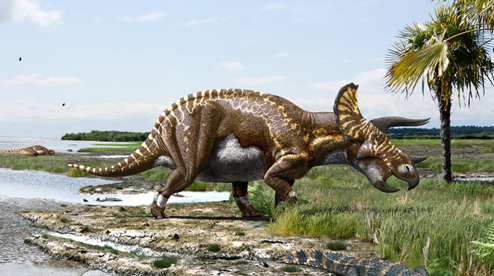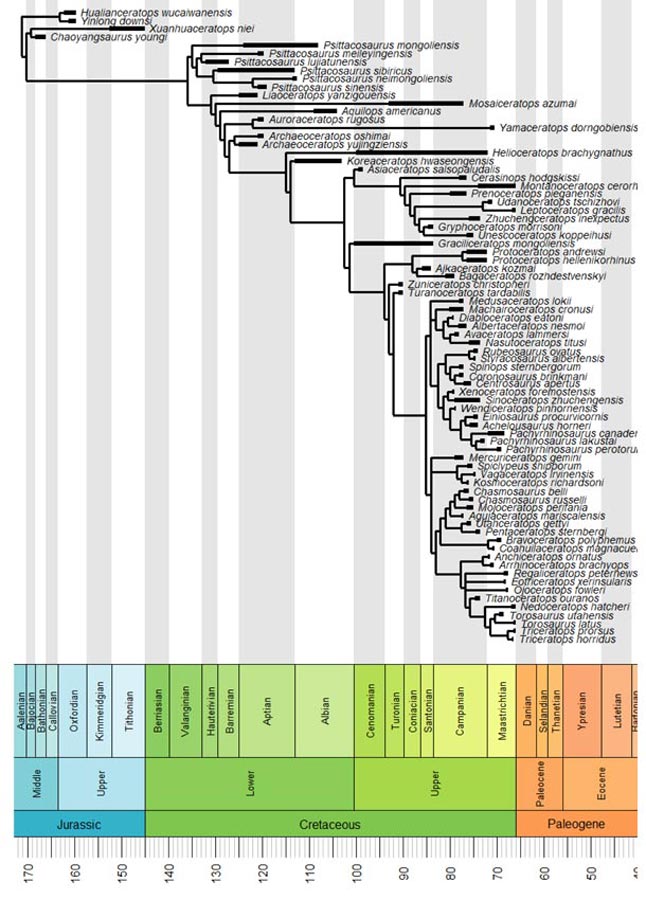A Horned Dinosaur Family Tree is Plotted by New Research
Ceratopsia Family Tree
Recently, Everything Dinosaur posted up an article that featured some remarkable research by an international team of scientists who set about answering the question, why did horned dinosaurs have fancy frills? The scientific paper detailing this fascinating study, undertaken by scientists from the Natural History Museum of Utah, the Raymond M. Alf Museum of Palaeontology (California) and the University of London has been published in the “Proceedings of the Royal Society B.”
To read our article: Why Did Horned Dinosaurs Have Fancy Frills?
A Horned Dinosaur Family Tree
The researchers conclude that there is no statistical evidence to support the idea that the elaborate horns, neck frills and bony outgrowths associated with the skulls of the Ceratopsia evolved to help with inter-species recognition. If a Centrosaurus (Centrosaurus apertus), happened to encounter an Achelousaurus (A. horneri), then it is likely that they used more subtle signals to help distinguish themselves. Although, inter-species recognition is discounted, the paper suggests that the amazing skull ornamentation evolved as a sign that the individual was genetically healthy and therefore an attractive mate.
The Horns of Triceratops Probably Played a Role in Demonstrating Fitness for Breeding

Picture credit: Julius Csotonyi
How Many Horned Dinosaurs and When Did They Live?
Before the statistical analysis could be carried out, the dedicated research team had to create a pool of horned dinosaur data to work with. To test the idea about fancy frills and huge horns having something to do with inter-species identification, the scientists had to work out when the species of horned dinosaur lived, where they lived and what other horned dinosaurs shared their habitat. In essence, an audit of the stratigraphical, geological and temporal evidence for the Ceratopsia (more than 70 species), had to be constructed.
Drawing on numerous sources, the research team compiled a time-scaled phylogeny for all the known ceratopsians. When each species of horned dinosaur lived was plotted against the geological timescale. In this way, a single chart could show which horned dinosaurs were contemporaneous.
When the Horned Dinosaurs Lived (Ceratopsians) Plotted Against Geological Time

Picture credit: Published in the Supplementary Section of the Scientific Paper*
The picture (above), shows a time-scaled phylogeny for all the ceratopsian species known at the time of compilation. Estimated temporal range of each species is indicated by the thick, black bars at the branch tips. This phylogeny was created using strap package for R. (Bell and Lloyd, 2014).
Middle Jurassic Origins
From their Middle Jurassic origins, the evolution of the horned dinosaurs can be outlined in a single figure. Dinosaur fans can see which ceratopsians lived at the same time as each other. They can also observe which horned dinosaurs are associated with the various faunal stages that make up the Jurassic and the Cretaceous.
The very last horned dinosaurs include the likes of Nedoceratops hatcheri, Torosaurus latus and Triceratops prorsus, this information can be found towards the bottom corner of chart. Note how the two recognised species of Triceratops T. horridus and the geologically younger T. prorsus are not contemporaneous. This reflects recently published research (2014), that mapped changes in the Triceratops fossil population and the evolution of a new species as the genus changed over time.
To read the article on the evolution of species within the Triceratops genus: How Triceratops Got Its Horns and Beak.
*The scientific paper: “Patterns of Divergence in the Morphology of Ceratopsian Dinosaurs: Sympatry is not a Driver of Ornament Evolution” by Andrew Knapp, Robert J. Knell, Andrew A. Farke, Mark A. Loewen, David W. E. Hone published in the Proceedings of the Royal Society B (Biology).
For models and replicas of horned dinosaurs: Horned Dinosaur and Prehistoric Animal Models.

